Contents
- 1. Manual 1
- 2. Users Manual 1
- 3. Users Manual 2
- 4. Users Manual 3
- 5. Users Manual 4
Users Manual 3
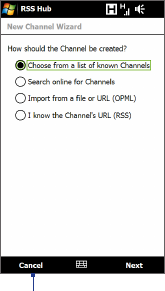
144 Internet
Using 8.6 RSS Hub
RSS Hub is an RSS reader that keeps you up-to-date with the latest news from the
Internet. It monitors RSS feeds from your favorite news sites, blogs and more, and
downloads the most current updates and podcasts.
For more information about RSS Hub, tap Start > All Programs > Help, and then
tap Help for Added Programs > RSS Hub.
Subscribing to and organizing news channels
You must subscribe to news channels before you can receive RSS feeds.
To subscribe to news channels
1. Tap Start > All Programs > RSS Hub,
and then tap Continue.
2. In the New Channel Wizard screen,
select the Choose from a list of
known Channels option, and then
tap Next. A list of RSS channels is
displayed.
Note If the RSS channel you want to
subscribe to is not in the list of
known channels, tap Back, then
select another option on the New
Channel Wizard screen.
Tap to load pre-selected RSS channels.
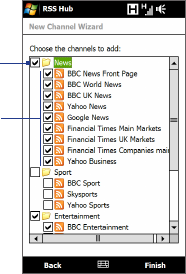
Internet 145
3. Select the checkboxes of the RSS channels you want to subscribe to, then tap
Finish.
Channels
Category
Tip Channels are grouped by categories. If you want to select all channels in a
category, select the category check box.
4. The channel list appears. Tap Refresh to update the channels.
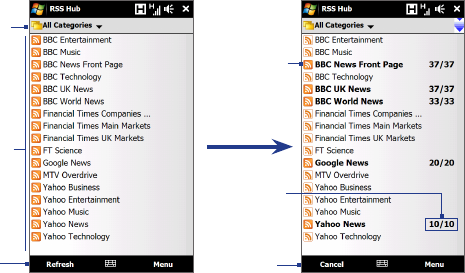
146 Internet
Cancel
channel
updating
Channel is
updated. Tap
to view the
headlines.
Select the
channel category
to display
Headline
count
Update the
channels
Channel list
To add new channels
1. In the channel list, tap Menu > Channel > New to open the New Channel
Wizard screen.
2. Select an option, and then follow screen instructions to add new channels.
To filter the channels to display
In the channel list, tap Menu > View, and then select Updated to display only
those channels with unread items, or All to display all subscribed channels.
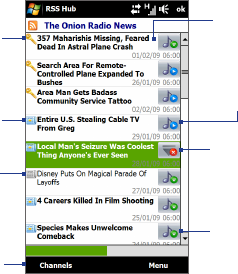
Internet 147
Using the headline list
Tap a channel in the channel list to display the headline list.
Tap a headline to open
the news summary
screen.
The item contains
a keyword.
Download the podcast
or image attachment.
Podcast or image
attachment is
downloading.
Play back the podcast
or view the image.
New or unread item
Item has been read
Return to the
channel list
New or unread items display in bold and are marked with a blue newspaper icon.
Items that have been read are marked with a gray newspaper icon.
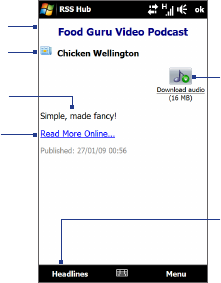
148 Internet
Viewing the news summary
Tap a headline in the headline list to display the news summary.
Headline and
read status Podcast or image
attachment. Tap the link
to download the file.
News summary
Open the complete
article in Opera
Mobile. See “Using
Opera Mobile” in this
chapter for details.
Channel name
Return to the
headline list
Tap Menu to change the way that text is displayed, save a podcast, send a link to
the article via e-mail, and more.
To download, play, or save podcasts
1. On the news summary screen tap the Download audio/Download video
link or the audio/video podcast icon.
Tip To cancel the file download, tap Cancel download below the audio/video file icon.
2. After downloading the file, do one of the following:
• Tap Play audio/Play video or the audio/video file icon to play back the file.
• Tap Menu > Podcast > Save to save a copy of the file to the device’s main
memory or storage card.
Internet 149
To send the a link to the article via e-mail
1. In the news summary screen, tap Menu > Send Link via Email.
2. Messaging opens and displays the Account Picker screen. Tap the e-mail
account that you want to use.
A new e-mail message is then created with the link.
3. Specify the e-mail recipients, and then tap Send.
Note For more information on how to compose e-mails, see “Creating and sending an
e-mail message” in Chapter 6.
To view the next or previous news summary
In the news summary screen, tap Menu > Next or Menu > Previous.
Using Your Phone as a Modem (Internet Sharing8.7 )
Internet Sharing connects your desktop or notebook computer to the Internet by
using your device’s data connection such as GPRS/3G. You can connect via USB or
Bluetooth.
Before you proceed
Make sure your device has a SIM card installed, and your device has a •
GPRS/3G or dial-up modem connection. If your device has not been set up
with a data connection yet, tap Menu > Connection Settings on the Internet
Sharing screen. For more information about setting up these connections,
see “GPRS/3G” and “Dial-up” in this chapter.
To set up your device as a USB modem, you must first install Windows Mobile •
Device Center or Microsoft ActiveSync version 4.5 or later on the computer.
To use a Bluetooth connection, make sure your computer has built-in •
Bluetooth capability. If your computer does not have Bluetooth, you can
connect and use a Bluetooth adapter or dongle.
150 Internet
Setting up your device as a USB modem
1. Connect the device to your desktop or notebook computer using the USB
sync cable.
2. When the Connect to PC screen appears, select Internet Sharing, then tap
Done.
3. In the Network Connection list, select the name of the connection that your
device uses to connect to the Internet.
4. Tap Connect.
Using your device as a Bluetooth modem
To use your device as a Bluetooth modem for your computer, set up a Bluetooth
Personal Area Network (PAN) between your device and your computer.
To set up Bluetooth PAN on your device
1. On your device, turn on Bluetooth and set it to visible mode. For instructions,
see “To turn Bluetooth on and make your device visible” in Chapter 9.
2. Initiate a Bluetooth partnership from your device. For instructions, see “To
create a Bluetooth partnership” in Chapter 9.
3. Tap Start > All Programs > Internet Sharing.
4. Select Bluetooth PAN as the PC Connection.
5. From the Network Connection list, select the name of the connection that
your device uses to connect to the Internet, and then tap Connect.
Internet 151
6. Set up Bluetooth PAN on your computer. For instructions, see “To set up
Bluetooth PAN on your computer”.
7. On the Internet Sharing screen on your device, check whether a connected
status message is displayed, which indicates that your computer has been
successfully connected to the Internet using your device as a Bluetooth
modem.
To set up Bluetooth PAN on your computer
For Windows Vista:
1. Click Start > Control Panel > Network and Internet > Network and
Sharing Center.
2. Click Manage network connections and then under Personal Area
Network, double-click Bluetooth Network Connection.
3. In the Bluetooth Personal Area Network Devices dialog box, select your
device, and click Connect.
For Windows XP:
1. Tap Start > Control Panel > Network Connections.
2. Under Personal Area Network, click the Bluetooth Network Connection
icon.
3. Under Network Tasks, click View Bluetooth network devices.
4. In the Bluetooth Personal Area Network Devices dialog box, select your
device, and click Connect.
Note If the Bluetooth adapter or dongle on your computer was installed using a
third-party driver, open the Bluetooth software that came with the Bluetooth
adapter/dongle to connect your computer and device via Bluetooth. Refer to the
Bluetooth adapter/dongle documentation for more information.
Ending the Internet connection
On the Internet Sharing screen, tap Disconnect.
152 Internet

Chapter 9
Bluetooth
Bluetooth9.1 Modes
Bluetooth is a short-range wireless communications technology. Devices with
Bluetooth capabilities can exchange information over a distance of about eight
meters (26 feet) without requiring a physical connection.
Bluetooth on your device operates in three different modes:
• On. Bluetooth is turned on. Your device can detect other Bluetooth-enabled
devices, but not vice versa.
• Visible. Bluetooth is turned on, and all other Bluetooth-enabled devices can
detect your device.
• Off. Bluetooth is turned off. In this mode, you can neither send nor receive
information using Bluetooth.
Note Turn off Bluetooth when not in use to conserve battery power, or in places where
using a wireless device is prohibited, such as on board an aircraft and in hospitals.
To turn Bluetooth on and make your device visible
1. Tap Start > Settings > Communications and then tap Bluetooth.
Tip You can also tap Start > Settings > All Settings > Connections tab and then
tap Bluetooth.
2. When prompted to turn on Bluetooth, tap Yes.
3. Tap the Settings tab ( ), and then tap Not Discoverable.

154 Bluetooth
4. Tap the drop-down menu and then select Always Visible.
Note If you select Visible for 60 seconds, Bluetooth visibility will turn off
automatically when the time elapses and your device has not yet connected to
another Bluetooth device.
5. Tap Done. The icon then appears in the title bar to indicate that the
device is in visible mode.
Tip To easily switch Bluetooth off or back on, tap Start > Settings > Communications to
open the Comm Manager and then tap Bluetooth’s OFF/ON slider.
Your device remembers whether visible mode was previously enabled or disabled. If
you did not disable visible mode, switching Bluetooth on in the Comm Manager also
puts your device in visible mode automatically. For more information about using the
Comm Manager, see Chapter 13.
Bluetooth Partnerships9.2
A Bluetooth partnership is a relationship that you create between your device and
another Bluetooth-enabled device in order to exchange information in a secure
manner.
To create a Bluetooth partnership
1. Tap Start > Settings > Communications and then tap Bluetooth.
2. On the Settings tab ( ), tap Add a device.
3. Tap a Bluetooth device to connect with.
4. Specify a passcode, which can be 1 up to 16 characters, to establish a secure
connection, and then tap OK.
Note Your device uses Bluetooth 2.1 with Secure Simple Pairing feature. If the other
Bluetooth device you are pairing with also supports the same feature, the
passcode will be automatically created and displayed on both devices. Both you
and other party simply need to verify that the passcode is the same and tap Yes
to establish the partnership.

Bluetooth 155
5. After the receiving party accepts the partnership, the Bluetooth device name
is shown on the screen, including all Bluetooth services that you can use with
it. Select the check boxes of the Bluetooth services you want to use, and then
tap Done.
6. If you selected to use the Bluetooth Serial Port service of the paired device,
select a local serial port to assign for the paired device, and then tap
Continue.
The connected Bluetooth device now appears in the Devices tab ( ).
Tip Tap Properties to change the paired device name. Tap Menu > Update to
update the list of services that you can use with the paired device.
Creating a Bluetooth partnership between two devices is a one-time process. Once
a partnership is created, the devices can recognize the partnership and exchange
information without entering a passcode again.
To accept a Bluetooth partnership
1. Ensure that Bluetooth is turned on and in visible mode.
2. When prompted, enter or accept the passcode (the same passcode from the
device requesting the partnership) to establish a secure connection.
3. Tap OK. The paired device now appears in the Devices tab ( ). You can
now exchange information with the paired device.
Tip To delete a Bluetooth partnership, select the device’s name on the Devices tab, then
tap Menu > Delete. When prompted to confirm, tap Yes.

156 Bluetooth
Connecting a Bluetooth Hands-free9.3 or Stereo
Headset
For hands-free phone conversations, you can use a Bluetooth hands-free headset
such as a car kit with your device. Your device also supports A2DP (Advanced Audio
Distribution Profile) which allows you to use a Bluetooth stereo headset for hands-
free phone conversations and for listening to stereo music.
To connect a Bluetooth hands-free or stereo headset
1. Make sure that both your device and the Bluetooth headset are turned
on and within close range, and that the headset is visible. Refer to the
manufacturer’s documentation to find out how to set the headset in visible
mode.
2. Tap Start > Settings > Communications and then tap Bluetooth.
3. On the Settings tab ( ), tap Add a device.
4. Select the hands-free or stereo headset device in the list, then tap Select.
Your device will automatically with the Bluetooth headset.
Note Your device will automatically try one of the preconfigured passcodes (0000,
8888) to pair with the Bluetooth headset. If this fails, you have to manually enter
the passcode delivered with your headset.
5. When connected, the hands-free or stereo headset device is shown on the
screen, including the Bluetooth services (Hands-free and Stereo Audio) that
you can use with it. Make sure these services are selected, and then tap
Continue.
The paired headset now appears in the Devices tab ( ).
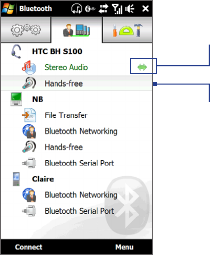
Bluetooth 157
If you turn off your headset, the double
arrowhead disappears to indicate that the
service has been disconnected. Next time
you turn on and use your headset again,
you need to manually reconnect each
service. Tap a service and then tap Connect.
The double arrowhead that is displayed
to the right of a service indicates that the
service is connected with your headset.
Sending and Receiving Information9.4 Using
Bluetooth
You can send the following types of information from your device to your computer
or to another Bluetooth-enabled device: Outlook e-mail, contacts, tasks, notes,
calendar items, audio files, ring tones, Images, and videos.
Note If your computer does not have built-in Bluetooth capability, you need to connect
and use a Bluetooth adapter or dongle on your computer.
To send information from your device to a computer
1. Turn on Bluetooth on your computer and set to visible mode.
Note If the Bluetooth adapter or dongle on your computer was installed using a third-
party provided driver, open the Bluetooth software that came with the Bluetooth
adapter/dongle and enable the adapter/dongle to be discovered by other
devices. Refer to the Bluetooth adapter’s documentation for more information.
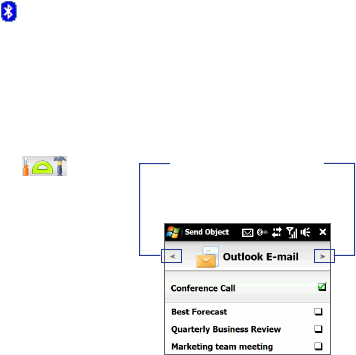
158 Bluetooth
If your computer is installed with Windows XP SP2 or later version and your
computer’s Bluetooth adapter is supported by your Windows version, do the
following steps:
a. On your computer, open Bluetooth Devices from the Control Panel, then
click the Options tab on the Bluetooth Devices window.
b. For Windows Vista, select Allow Bluetooth devices to find this computer.
For Windows XP, select Turn discovery on and Allow Bluetooth devices
to connect to this computer.
c. Create a Bluetooth partnership between your device and computer. For
instructions, see “To create a Bluetooth partnership”.
d. In the Options tab of Bluetooth Devices, select Show the Bluetooth
icon in the notification area.
e. To enable your computer to receive information via Bluetooth, right-click
the Bluetooth icon in the notification area at the bottom-right corner
of your computer screen and select Receive a File. You are now ready to
send/receive.
2. Turn on Bluetooth on your device and make your device visible. For
instructions, see “To turn Bluetooth on and make your device visible”.
3. Create a Bluetooth partnership. For instructions, see “To create a Bluetooth
partnership”.
4. Tap the Accessories tab ( ), and
then tap BT Send Object.
5. Select the type of information and then
select the check boxes of items you
want to send.
6. Tap Send.
7. Select the Bluetooth device to which
you want to send the items, then tap
Select.
Tap the left or right arrow
to change to the type of
information you want
to send.

Bluetooth 159
8. If you sent Outlook E-mail messages, calendar items, tasks, or contacts to
your computer and they are not automatically added to Outlook, select File >
Import and Export in Outlook to import them.
To send information to a Bluetooth-enabled device such as another Windows
Mobile-powered device, follow steps 2 to 7 in the above procedure.
Tip The default folder on your computer where sent items are stored may be
C:\Documents and Settings\your_username\My Documents\Bluetooth Exchange
Folder in Windows XP or C:\Users\your_username\My Documents\Bluetooth
Exchange Folder in Windows Vista.
To send a file to another Bluetooth-enabled device
1. Tap Start > All Programs > File Explorer.
2. Navigate to the folder that contains the file you want to send.
3. Tap and hold the desired file, and then tap Send via Bluetooth.
4. Select the name of the Bluetooth device, and then tap Select.
To receive information from another Bluetooth-enabled device
1. When you receive information such as calendar items, tasks, or contacts sent
from another Bluetooth-enabled device, tap Accept.
2. After your device has finished saving the information, tap Done.
To change the folder for saving received files
Files that you receive from another Bluetooth-enabled device are saved in
\My Documents on your device. You can change the destination folder for saving
received files:
1. Tap Start > Settings > Communications and then tap Bluetooth.
2. On the Settings tab ( ), tap Advanced.
3. Scroll down and then tap File Transfer.
4. Tap Search ( ).

160 Bluetooth
5. Select the new destination folder, and then tap Select.
Tip To save received files on your storage card when it is inserted on your device,
select Save files to storage card when present. Files will be saved on the root
folder of your storage card.
6. Tap Done.
Printing9.5 via Bluetooth
Connect your device to a Bluetooth printer to print your pictures.
Note Before you start printing, make sure to turn on the Bluetooth printer and turn on
Bluetooth on your device. For instructions, see “To turn Bluetooth on and make your
device visible” earlier in this chapter.
To print a picture
1. Tap Start > Settings > Communications and then tap Bluetooth.
2. Tap the Accessories tab ( ), and then tap Print Images. Your device
then searches for pictures that are stored on your device and storage card.
3. Tap each picture that you want to select for printing. To select all pictures, tap
Menu > Select All.
Tip To clear a selected picture, tap that picture again.
4. After you have finished selecting pictures, tap Next.
5. Select the name of the Bluetooth printer, and then tap Select.
6. Select the Print Layout to use, and then tap Print.

Bluetooth 161
Connecting to 9.6 Car Kit Phones
Bluetooth car kit phones that support the SIM Access Profile (SAP) can connect to
your device and access its SIM card via Bluetooth. Once a SAP connection has been
established, you can download device and/or SIM contacts from your device to the
car kit phone, and use the car kit phone to answer and make calls.
1. Tap Start > Settings > Communications and then tap Bluetooth.
2. Turn Bluetooth on and set your device to visible mode. For instructions, see
“To turn Bluetooth on and make your device visible” earlier in this chapter.
3. On the Settings tab ( ), tap Advanced.
4. Scroll down and tap SIM Access.
5. Select the Enable SIM Access Profile (SAP) check box, and then tap Done.
6. Connect the car kit phone to your device via Bluetooth. For instructions, refer
to your car kit phone’s manual.
7. If this is the first time you are pairing the car kit phone with your device, enter
the car kit phone’s passcode on your device.
8. A pop-up message should appear on your device saying that a connection
has been established between your device and car kit phone. Tap OK.
Note You are not able to make and receive calls, send and receive messages, or perform
related activities on your device when the SIM Access Profile connection is active.
You’ll be able to make or receive calls from the car kit phone during this time. After
the connection is disconnected, you will be able to use your device as before.
162 Bluetooth
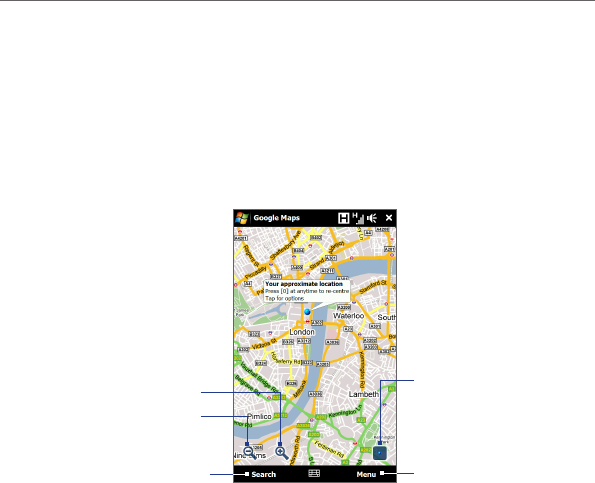
10.1 Google™ Maps (Available by Country)
Google™ Maps lets you track your current location, view real-time traffic situations,
and receive detailed directions to your destination. It also allows you to search and
locate places of interest or even a contact address.
Note You need an active data or Wi-Fi connection to use Google Maps.
To open Google Maps, tap Start > Google Maps.
Zoom out
Zoom in
Search for places
Get directions, see
traffic information,
and more.
View your current
location.
Chapter 10
Navigating on the Road
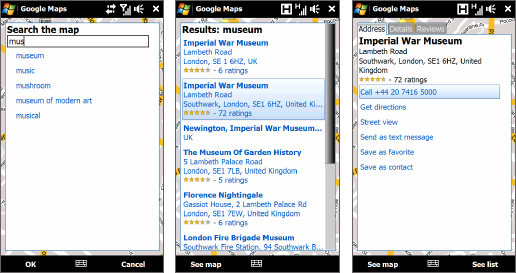
164 Navigating on the Road
Notes • Traffic information is available only in some selected cities.
• Tap Menu > Help > Tips to learn more about the program and its many features.
Searching a place of interest
Google Maps lets you search and locate a place of interest, shows the contact
information for that place, and gives directions on how to get there from your
current location.
1. On the Google Maps screen, tap Search.
2. Enter the name, address, or postal code of the place on the search field and
then tap OK.
3. In the search results list, tap the place to view its address, phone number, and
other details.
Navigating on the Road 165
4. On the Address tab, tap:
• The [phone number] to call the place of interest.
• The web address (if available) to go to the web site of the place of
interest.
• Get directions to get directions to the place of interest from your current
location.
• Street view (available by country) to display a street view of the place of
interest, when available.
• Send as text message to send the place’s contact information to your
contact via SMS.
• Save as favorite to add the place of interest to your list of favorite places.
To access your favorite places, on the Google Maps screen, tap Menu >
Favorites.
• Save as contact to save the contact information of the place of interest to
your contacts list.
5. Tap See map to view the place of interest on the map.
For more information about Google Maps, go to
http://www.google.com/gmm/index.html.
Guidelines and Preparation for Using 10.2 GPS
If you installed a GPS navigation software on your device, follow these guidelines
before and when using your device for GPS navigation.
• When using GPS navigation software in the car, always plot your GPS route
before starting to drive. Do not try to configure the GPS navigation software
while driving.
• The plotted GPS route is only for driving reference. It should not interfere with
actual driving behavior.

166 Navigating on the Road
• Do not leave your device in a vehicle or expose the device to direct sunlight
to avoid overheating the battery, which could pose damage to the device or
risk to the vehicle.
•When using the device inside a vehicle, use the car holder to mount the
device securely in place. Avoid placing the device in the areas shown in the
following diagram:
1 Do not place where it will block the driver’s vision.
2 Do not place where air bags could deploy.
3 Do not place anywhere in the vehicle without securing the device in the holder.
•Use the GPS system cautiously. Users shall be liable for any damages resulting
from negligent operation of the system.
• The GPS signal cannot pass through solid non-transparent objects. Signal
reception may be affected by obstructions such as high-rise buildings,
tunnels, bridges, forests, weather (rainy or cloudy days), etc. If the vehicle’s
visor contains metal, it will be difficult for the GPS signal to pass through.
• Other nearby wireless communication products (such as mobile phones or
radar-detecting devices) may interfere with the satellite signal, resulting in
unstable signal reception.
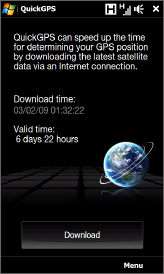
Navigating on the Road 167
• The Global Positioning System (GPS) is built and operated by the US
Defense Department. The Department is responsible for the accuracy and
maintenance of the system. Any changes that the Department makes may
affect the accuracy and function of the GPS system.
10.3 Downloading Location Data via QuickGPS
Before using the device for GPS navigation, open QuickGPS to download
ephemeris data (current satellite position and timing information). QuickGPS
significantly speeds up the time for determining your GPS position. QuickGPS
downloads ephemeris data from web servers, instead of from satellites, using your
device’s Internet connection via Wi-Fi, ActiveSync or GPRS/3G.
To open QuickGPS
Tap Start > All Programs > QuickGPS.
To download GPS data
Tap Download on the QuickGPS screen.
On the screen, initially, you will see the Valid
time of the downloaded data. As time passes,
the remaining days and hours of validity will be
shown.
To speed up GPS positioning, download the
latest ephemeris data when the validity of the
data expires.
168 Navigating on the Road
Changing the download options
To configure download options, tap Menu > Options and choose from available
options:
• Remind me when data expires.
Display a message when ephemeris data expires.
• Auto download when data expires.
Automatically download ephemeris data when it expires.
• Auto download when connected to PC via ActiveSync.
Automatically download ephemeris data when it is connected to your
computer via ActiveSync. Your computer must be connected to the Internet
to download ephemeris data.
• Exit QuickGPS after downloading.
Close QuickGPS after satellite data is downloaded.
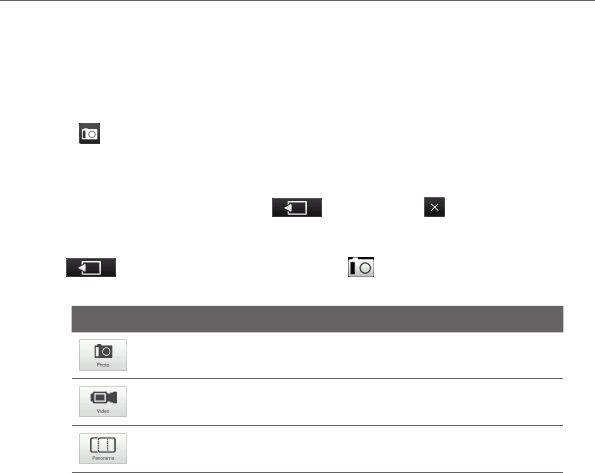
Chapter 11
Camera and Multimedia
Taking Photos and Videos11.1
Use Camera to take photos and record video clips.
To open the Camera screen
On the Home screen, slide to the Photos and Videos tab and then tap the camera
icon ( ). The screen orientation automatically switches to landscape mode when
you open Camera.
To close the Camera
Tap the On-screen control button ( ), and then tap .
Changing the capture mode
Tap , then tap the capture mode icon ( — the icon displayed is based
on the current capture mode). On the menu, tap the capture mode you want to use.
Icon Capture Mode
Captures standard still images.
Records video clips, with or without audio.
Captures still images continuously in one direction, and then
stitches them to create a panoramic view of a scenery.
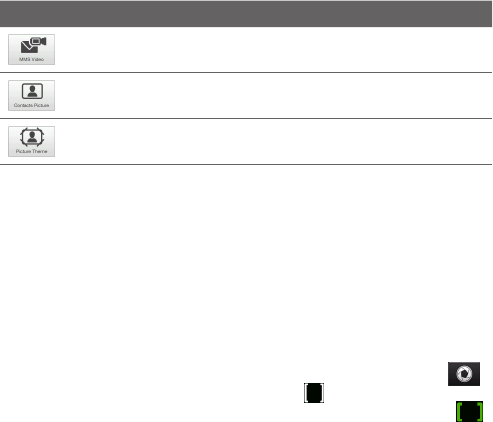
170 Camera and Multimedia
Icon Capture Mode
Records video clips suitable for sending via MMS.
Captures a still image that you can assign as a contact picture.
Captures still images and places them within frames.
Note When using the second camera to capture, you can use all modes, except for
Panorama.
Using the focus
Use the automatic focus or Touch Focus function to capture sharp and crisp photos
and videos.
Note The second (front) camera has no auto-focus function.
Auto-focus
Auto-focus sets the focus on the object at the center of the screen and is available
for all capture modes. By default, touching the Virtual Camera button ( )
activates auto-focus and a flashing white bracket ( ) appears in the center of the
screen. When focus is set, the bracket changes to a steady green bracket ( ), and
then the Camera takes the photo or starts to record the video.
Touch Focus
Touch Focus allows you to focus on a particular area of the screen. Touch Focus is
enabled by default and is only available for Photo or Contacts Picture mode.
Note To disable Touch Focus, see “Setting advanced options” in this chapter.

Camera and Multimedia 171
To use Touch Focus:
1. Set the Camera to Photo or Contacts Picture mode.
2. Touch the area on the screen that you want to focus. The Touch Focus
indicator ( ) positions itself on the selected area.
Note If you tap outside the effective focus area, a white box appears to indicate the
area where you can use Touch Focus.
3. Touch to activate auto-focus on the selected area and take the photo.
See “Auto-focus” in this chapter for more information.
Tip To move the Touch Focus indicator back to the center of the screen, tap .
Capturing photo or recording video
By default, the Camera automatically takes the shot or starts capturing video after
you have set the focus.
• In Photo or Contacts Picture mode, touch the Virtual Camera button to
activate auto-focus; when focus is set, the Camera automatically takes the shot.
• In Video or MMS Video mode, touch the Virtual Camera button to activate
auto-focus; when focus is set, the Camera automatically starts recording.
Touch the Virtual camera button again to stop recording.
• In Picture Theme or Panorama mode, touch the Virtual Camera button to
activate auto-focus; when focus is set, the Camera automatically takes the
first shot. Do the same for each shot you need to take.
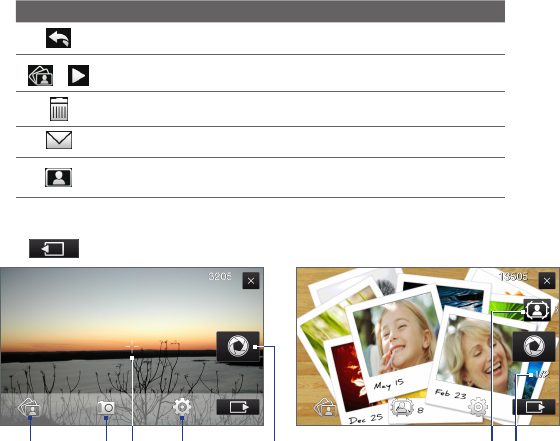
172 Camera and Multimedia
The Review screen
After capturing a photo or recording video, the Review screen gives you the option
to view/play, send, or delete the photo or video clip.
Icon Function
Return to the live Camera screen.
/ View the captured image or play the captured video in Album.
See “Viewing Photos and Videos Using Album” in this chapter.
Delete the captured image or video.
Send the captured image or video via MMS or e-mail.
After capturing in Contacts Picture mode, tap to assign the photo to
a contact.
On-screen controls
Tap to display the on-screen controls.
752 31 4 6
1 Album. Open the Album program. See “Viewing Photos and Videos Using
Album” for details.
2 Capture mode. See “Changing the capture mode” for details.
3 Touch Focus / Auto-focus indicator. See “Using the focus” for details.
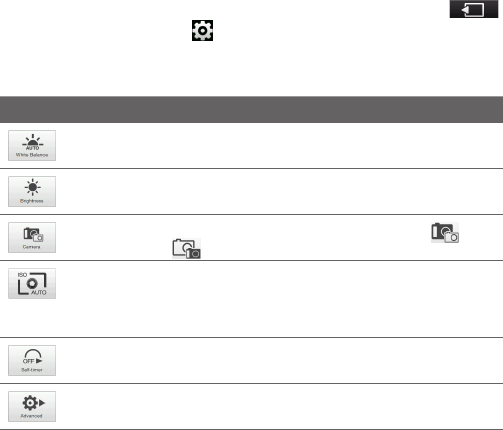
Camera and Multimedia 173
4 Menu. Open the Menu Panel. See “Menu Panel” for details.
5 Virtual Camera button. Activates the auto-focus and functions as the shutter
release button.
6 Template Selector icon. In Picture Theme mode, tap to select another frame.
7 Progress indicator. In Picture Theme and Panorama modes, this shows the
number of consecutive shots.
Menu Panel
The Menu panel lets you quickly adjust common camera settings and provides
access to more advanced camera settings. To open the Menu panel, tap on
the Camera screen, and then tap . To adjust a setting, keep tapping a button, for
instance, White Balance, to cycle through the available settings.
Note The available menu panel buttons depend on the selected capture mode.
Icon Function
Select the white balance setting according to the current lighting
condition to capture colors more accurately.
Open the Brightness bar and adjust the brightness level. Tap outside the
Brightness bar to apply the change.
Select the camera to use. You can choose from main camera ( ) or
second camera ( ).
Set the ISO level manually to 100, 200, 400, or 800, or set it back to
AUTO. Higher ISO numbers are better for taking pictures in low light
conditions.
Note The camera automatically adjusts the ISO level up to 400 only.
Set the self-timer to 2 seconds, 10 seconds, or Off when in Photo or
Contacts Picture mode.
Open the advanced camera settings. See “Setting advanced options” for
details.
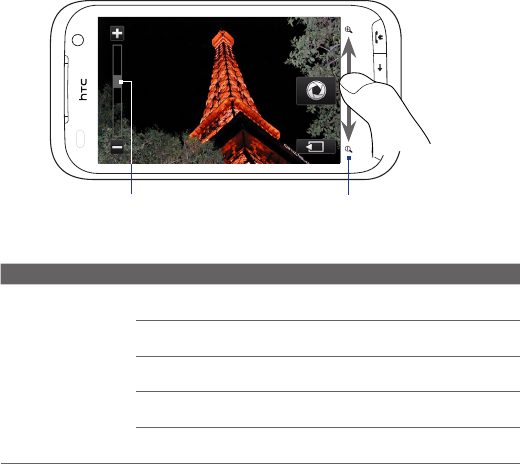
174 Camera and Multimedia
Zooming
Before capturing a photo or a video clip, you can zoom in or out on your subject.
To zoom in or out, slide your finger up or down on the Zoom bar while holding the
device sideways. While you are sliding your finger on the Zoom bar, the level of
zoom is shown on the zoom control bar on the screen.
Zoom control bar Zoom bar
The camera zoom range for a photo or a video clip depends on the capture mode
and resolution. Refer to the table for more information.
Capture mode Resolution Zoom range
Photo 3M Normal: 2048 x 1536
Widescreen: 2048 x 1216 1.0x to 1.6x
2M Normal: 1600 x 1200
Widescreen: 1600 x 960 1.0x to 1.6x
1M Normal: 1280 x 960
Widescreen: 1280 x 768 1.0x to 1.6x
LNormal: 640 x 480
Widescreen: 640 x 384 1.0x to 1.6x
MNormal: 320 x 240
Widescreen: 320 x 192 1.0x to 3.2x
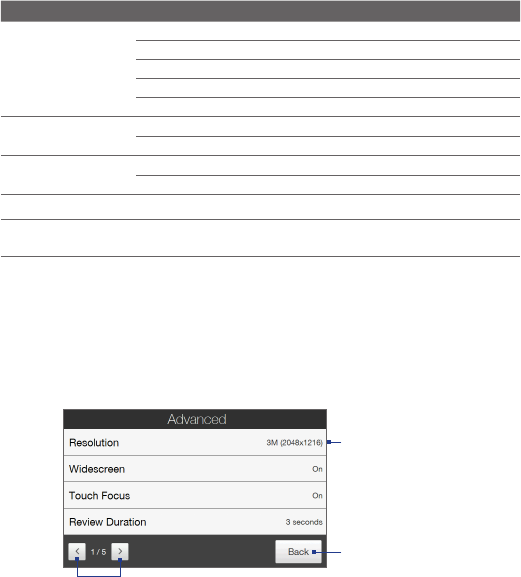
Camera and Multimedia 175
Capture mode Resolution Zoom range
Video VGA 640 x 480* 1.0x to 1.6x
CIF 352 x 288 1.0x to 1.6x
L 320 x 240 1.0x to 1.6x
M 176 x 144 1.0x to 1.6x
S 128 x 96 1.0x to 1.6x
MMS Video M 176 x 144 1.0x to 1.6x
S 128 x 96 1.0x to 1.6x
Panorama L 640 x 480 1.0x to 1.6x
M 320 x 240 1.0x to 3.2x
Contacts Picture M 272 x 272 1.0x to 3.2x
Picture Theme Determined by the current
template
Depends on the size of
the selected template
* Available only in some models.
Note The capture resolutions and zoom ranges are only for the main camera.
Setting advanced options
The Advanced options let you adjust options for your selected capture mode and
set Camera program preferences. Tap Advanced on the Menu panel to open the
Advanced screen.
Tap to navigate through the
Advanced option screens.
Tap to go back to
the Camera screen.
Tap an item to
change the setting.
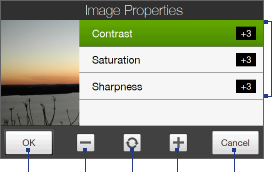
176 Camera and Multimedia
• Resolution. Select the resolution to use.
• Widescreen (Photo mode). When On (default) you can use the entire screen as
viewfinder. Refer to the zoom table for the resolution when Widescreen is On.
• Touch Focus (Photo and Contacts Picture modes). Enables or disables the
Touch Focus function. Touch Focus is On by default.
• Review Duration. Set the time for a captured photo/video to remain on the
Review screen.
• Quality. Select the image quality level for captured photos.
• Capture Format (Video and MMS Video modes). Select the file format for
recorded videos.
• Time Stamp (Photo mode). Include the date and time on captured photos.
• Storage. Select where to save photos and videos. You can either save the files
to the main memory, or to a storage card if available.
• Keep Backlight. Turn the backlight on or off. This overrides your device
backlight settings while you are using the camera.
• Shutter Sound. Play a shutter sound when you tap the Virtual Camera button.
• Image Properties. Adjust the image properties.
1Tap a property to adjust.
2Save the settings.
3Decrease the value.
4Reset all properties to default.
5Increase the value.
6Close the Image Properties
screen without applying and
saving the changes.
42 53 6
1
• Effect. Apply a special effect to your photos or videos.
Camera and Multimedia 177
• Metering Mode. Select a metering mode to allow the camera to measure the
amount of light and calculate the best-fit exposure value before capturing.
• Prefix. The file name of a newly captured photo or video is set to “IMAGE” or
“VIDEO” followed by a sequential number, for example: IMAGE_001.jpg. You
can also choose the current date or date and time as the file name prefix.
Note You can not change the file name prefix when saving captured photos to a
storage card. Captured photos are named using the convention IMAGnnnn.jpg
(where ‘nnnn’ is the counter), and are saved to the \DCIM\100MEDIA folder on
the storage card.
• Counter. Reset the file naming counter back to 1.
• Flicker Adjustment. When taking indoor shots under fluorescent lighting,
keep this setting on Auto or change it to the proper frequency (50Hz or 60Hz)
of the power in your country to reduce flicker.
• Grid (Photo mode). Show a grid on the screen so you can easily frame and
center your subjects.
• Record with Audio (Video or MMS Video mode). Select On to record videos
with audio, or Off to record videos without audio.
• Recording Limit (Video mode). Set the maximum duration or file size for
recording video.
• Template (Picture Theme mode). Select a template.
• Template Folder (Picture Theme mode). By default, templates are stored in
the \My Documents\Templates folder on the device’s Main Memory. If you
transferred some templates to a storage card, set this option to Main + Card.
• Show Reminder (Contacts Picture mode). Select On if you want the Camera
to prompt you to assign the captured picture to a contact.
• Direction (Panorama mode). Choose the direction in which to stitch the
photos in a panorama.
• Stitch Count (Panorama mode). Select the number of shots to take and stitch
into a panorama.
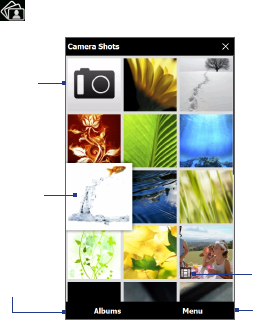
178 Camera and Multimedia
Viewing Photos and Videos Using 11.2 Album
Use Album to view photos and videos in your device.
To open Album
On the Home screen, slide to the Photos and Videos tab, and then tap Album.
You can also tap while on the Camera program to open Album.
Open the Camera
program.
Play the video file.
View the photo
in full screen.
View another album. Start a slideshow, set the
album as favorite, and more.

Camera and Multimedia 179
Viewing photos
While viewing a photo, tap the screen to open the menu.
Return to the
previous screen.
Start the slideshow.
Send the photo using
e-mail or MMS.
Save the photo
as a contact
picture, save the
on-screen image
as a new file, and
more.
To view the next or previous photo in the album
When you are holding your device upright, view the next or previous photo by
swiping your finger up or down the screen.
When you turn your device sideways, view the next or previous photo by swiping
your finger left or right across the screen.
To zoom in or out on an photo
Double-tap the area on the photo you want to zoom in on. To zoom out, double-
tap the screen again.
Tips • Use the zoom bar to zoom in on the center of the photo. Slide your finger to the
right of the zoom bar to zoom in. Slide to the left of the zoom bar to zoom out.
• When you zoom in on a photo, tap and hold the screen to pan and view other
areas of the photo. When you zoom in on a photo, tap the screen, tap and then
select Save Screen Image to save the zoomed in photo as a new file.
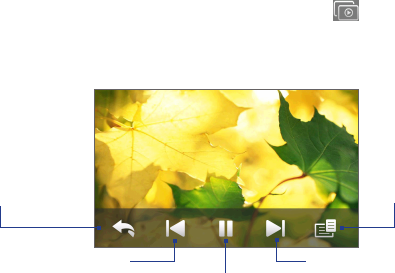
180 Camera and Multimedia
To view a slideshow of photos in the current album
While viewing a photo, tap the screen, and then tap .
Note Animated GIF and video files are excluded from the slideshow.
During the slideshow, tap the screen to show the playback controls.
Go back to the
previous image.
Set the transition
effect, time per slide,
and orientation of
the photos.
Return to the
previous screen.
Play or pause the slideshow.
Go to the next image.
Tip If the photos are in your favorite album, you can start the slideshow from the Photos
and Videos tab on the Home screen. See “Photos and Videos” in Chapter 3 for details.
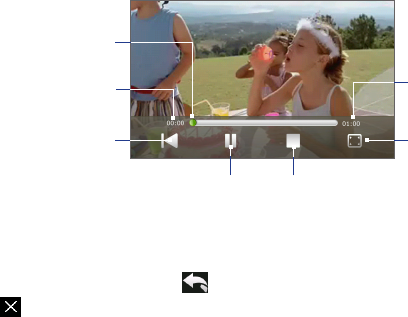
Camera and Multimedia 181
Playing videos
While playing back video, tap the screen to show the playback controls.
Change the video
display mode to Fit
& Crop (default),
Best Fit, or Stretch.
Go back to the
beginning of
the video.
Play or pause
the video.
Stop the video.
Drag to go forward or
backward in the video.
Elapsed time Total duration
Closing Album
When viewing photos in full screen, tap the screen to show the on-screen menu or
playback controls and then tap to go back to the main Album screen.
Tap on the main Album screen to close Album.
182 Camera and Multimedia
Using Windows Media® Player11.3 Mobile
Windows Media® Player Mobile plays digital audio and video files that are stored
on your device or on the web.
To open Windows Media® Player Mobile
Tap Start > All Programs > Windows Media.
Windows Media® Player Mobile opens with the Library screen. Use the Library
screen to find and play songs, videos, and playlists that are stored on your device or
on the storage card.
Playing media
To update the Library
In most cases, Windows Media® Player Mobile automatically updates the library.
However, you can manually update the library to ensure that it contains new files
that you recently copied to your device or to the storage card. Tap Menu > Update
Library to manually update the library list.
To play audio and video files
1. On the Library screen, tap the Library arrow (near the top of the screen), then
tap the media storage that you want use, for example, Storage Card.
2. Select a category (for example, My Music or My Playlists).
3. Tap and hold the item that you want to play (such as a song, album, or artist
name), and then tap Play.
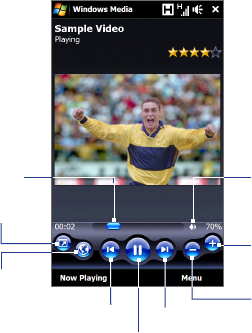
Camera and Multimedia 183
The playback screen opens and plays the audio or video file.
Play/Pause
Full screen
Visit WindowsMedia.com
Drag to jump to any
part of the video or
audio.
Skip to the beginning of
the current file or to the
previous file.
Skip to the next file.
Mute/Unmute
Increase volume
Decrease volume
Synchronizing video and audio files
Use the latest version of Windows Media® Player on your computer to synchronize
digital media files from your computer to your device. This ensures that protected
files and album art (for skins) are correctly copied to your device.
To automatically synchronize content to your device
1. On your computer, open Windows Media® Player, then connect your device to
your computer.
2. In the Device Setup Wizard, select Yes, search my computer now.
184 Camera and Multimedia
Note If you have previously opened Windows Media® Player and searched for media
on your computer, you are not prompted to search your computer in step 2.
3. On the Device Setup dialog box, enter a name for your device and click
Finish.
Note If you installed a storage card that has a capacity of more than 4GB and
your entire library can fit into the storage card, Windows Media Player will
automatically synchronize your music files. The device also needs to be set to
Disk Drive mode for Windows Media Player to automatically synchronize.
4. On the left panel of Windows Media® Player, right-click the name of your
device and click Set Up Sync.
Note To set up media synchronization on a storage card, right-click Storage Card in the
left panel of Windows Media® Player, then click Set Up Sync.
5. Select the playlist(s) that you want to sync between your computer and
device, then click Add.
Note On the Device Setup dialog box, make sure that the Sync this device
automatically check box is selected.
6. Click Finish.
The files begin synchronizing to your device. The next time you connect your device
to your computer while Windows Media® Player is running, synchronization will
start automatically.
To manually synchronize content to your device
1. If you have not set up media synchronization between your device and
computer, follow steps 1 to 3 in “To automatically synchronize content to your
device”.
2. Click the Sync tab on the Windows Media® Player of your computer. Select a
Playlist or a Library on the left panel of the Windows Media® Player.
3. From the Content List, drag the media files that you want to sync to your
device and drop them to the Sync List.
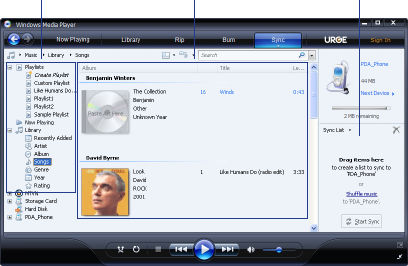
Camera and Multimedia 185
Playlists and Library List Sync ListContent List
4. Click Start Sync to start synchronizing the selected files to your device.
Notes • Use Windows Media® Player 11 or higher on your computer to synchronize media
files to your device.
• Audio files copy faster if Windows Media® Player is configured to automatically set
the quality level for audio files copied to your device. For more information, see the
Windows Media® Player Help.
Creating playlists
Create a new playlist by saving the current Now Playing playlist and giving it a new
name.
To save a new playlist
1. If you are not on the Library screen, tap Menu > Library.
2. Tap to select a category (for example, My Music or My Playlists).
186 Camera and Multimedia
3. Select a media file that you want, then tap Menu > Queue Up. This adds the
file to the Now Playing list. Repeat this step until you have added all desired
media files to the Now Playing list.
Note You cannot select multiple files simultaneously.
4. After adding the media files, tap Menu > Now Playing.
5. On the Now Playing screen, tap Menu > Save Playlist.
6. Enter the playlist name, then tap Done.
7. To play back the playlist you created, tap My Playlists in the Library, select
your playlist, then tap Play.
Troubleshooting
For troubleshooting information, visit http://www.microsoft.com/windowsmobile/
en-us/help/more/windows-media-player.mspx
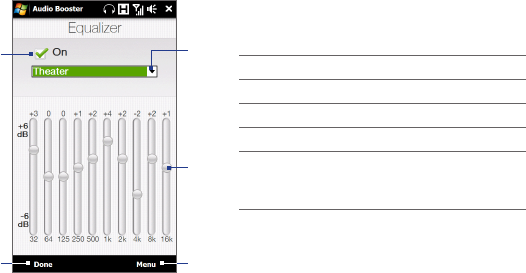
Camera and Multimedia 187
Using 11.4 Audio Booster
Audio Booster optimizes sound by providing an audio equalizer for a better listening
experience. To use Audio Booster, connect the supplied wired headset to your device.
To open Audio Booster
Tap Start > All Programs > Audio Booster.
13
2
4
5
1Enable or disable the equalizer.
2Apply the modified settings.
3Choose the equalizer preset to use.
4Drag the sliders to adjust the frequency.
5Exit Audio Booster without applying
the modified settings, or save or delete
preset equalizer settings.
To create a custom equalizer preset
1. Adjust the frequency bands to your desired values by dragging the equalizer
controls.
2. When finished, tap Menu > Save as Preset.
3. Enter a preset name and then tap Done. The equalizer preset is added to the
preset list box.
Note To delete a custom equalizer preset, select it on the preset list box and then tap
Menu > Delete Preset. You cannot delete pre-installed equalizer presets.
188 Camera and Multimedia

Chapter 12
Programs
Managing Programs12.1
Launching a program
Tap Start > All Programs, and then tap a desired program. To view more programs,
scroll down the screen by swiping your finger upward. See “Start Screen” in
Chapter 1 for details.
Installing a program
You can install or uninstall additional programs. Your device does not allow you to
uninstall most of the preinstalled programs.
Note Before you purchase additional programs, make sure that they are compatible with
your device.
Before you launch the program installer, check first whether the installer can
directly run on Windows Mobile or needs to be run on a computer.
To install a program directly on your device
1. If the installer is a .cab file, directly download or copy it to your device.
2. On your device, open File Explorer and navigate to the installer file.
3. Tap the file to launch the installer.
190 Programs
4. Choose whether to install the program into the main memory or your storage
card, if you have the storage card inserted on your device.
5. Wait for the installation to complete.
Note You may be prompted to restart your device after installation is completed.
To install a program from your computer
1. If the installer is an .exe file such as Setup.exe, most likely, the installer needs
to be run on a computer. Download or copy it to your computer.
2. Connect your device to your computer using the USB cable, and then double-
click the installer file on your computer to launch the installer.
3. Follow the on-screen instructions on your computer and your device to
complete the installation.
To uninstall a program
1. Tap Start > Settings, and then tap All Settings.
2. On the System tab, tap Remove Programs.
3. In the Programs in storage memory list, select the program you want to
remove, and then tap Remove.
Programs 191
Contacts12.2
Contacts is your address book for people and businesses you communicate with.
You can add Outlook contacts from your device or synchronized with your PC
or the Exchange Server, SIM contacts stored on the SIM card, or Windows Live™
contacts.
Note You can only add Windows Live™ contacts after you have set up Windows Live™ on
your device. See “Using Windows Live™” in Chapter 8.
To open the Contacts screen
Tap Start > All Programs > Contacts.
Adding new contacts
To add a contact on your device
1. On the Contacts screen, tap New, select Outlook Contact, and enter the
contact information.
2. In the File as field, choose how you want the contact name to appear in the
contact list.
3. To add a photo of the contact, tap Select a picture, and then select the
picture file or tap Camera to take a photo of the contact.
4. To assign a ring tone to the contact, tap the Ring tone field, scroll through
the list of tones, then select a desired tone.
5. When finished, tap OK.
Tip To edit contact information, tap the contact name and then tap Menu > Edit.
To add a contact to your SIM card
1. On the Contacts screen, tap New, then select SIM Contact.
2. Enter a contact name and phone number, and then tap OK.
Tip You can also use the SIM Manager to add and edit contacts on your SIM card. For
more information, see “SIM Manager” in this chapter.
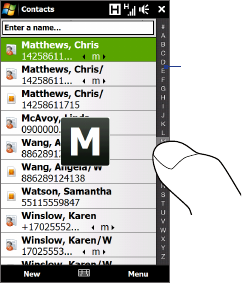
192 Programs
Organizing and searching contacts
To group similar contacts
For easier contact management, you can group contacts by assigning them into
categories.
1. Create a new Outlook contact or edit an existing Outlook contact.
2. Tap Categories.
3. Select a preset category such as Business or Personal, or tap New to create
your own category.
4. When finished, tap OK.
To find a contact on your device
There are several ways to find a contact when your contact list is long:
Begin entering a contact name in the provided text box until the contact you •
want is displayed.
On the Quick Scroll bar on the right •
of the Contacts screen, scroll to or
tap a letter to go directly to the part
of the contacts list where contact
names start with that letter.
Note You can disable the Quick
Scroll bar by tapping Menu >
Options and selecting the Show
alphabetical index check box.
This shows the alphabetical index
at the top of the Contacts list.
Filter the list by categories. In the •
contact list, tap Menu > Filter, then
tap a category you’ve assigned to a
contact. To show all contacts again,
select Menu > Filter > All Contacts.
Quick
Scroll
bar
Programs 193
Sharing contact information
You can quickly send contact information to another mobile phone or device
through Bluetooth beaming or text messaging.
To send contact information via Bluetooth
1. Tap and hold a contact on the Contacts screen.
2. Tap Send via Bluetooth, then select the device where to send the contact.
Note Before sending, make sure Bluetooth is turned on and set to visible mode on your
device and the target mobile device. You can also send contact information to your
computer. See Chapter 9 for details.
To send contact information via text messaging
1. Tap and hold a contact on the Contacts screen.
2. Tap Send Contact > SMS / MMS.
3. Select the contact information you want to send, and then tap Done.
4. In the new text message, enter the mobile phone number of the recipient,
and then tap Send.
194 Programs
JBlend12.3
Use JBlend to download, install and manage MIDlets or MIDlet suites on your
device. MIDlets are Java applications such as games and tools that can run on
mobile devices, while a MIDlet suite is a collection of one or more MIDlets. Your
device supports Java 2 Micro Edition (J2ME).
To open JBlend
Tap Start > All Programs > JBlend.
Installing and launching MIDlets/MIDlet suites
To download and install from the Internet
1. Open an Internet browser, such as Opera Mobile.
2. Navigate to the web page with the link for the MIDlet/MIDlet suite you want
to download, and tap the link.
3. Follow the onscreen instructions to install and run the MIDlet/MIDlet suite.
To install from your device
You can copy MIDlets/MIDlet suites from your PC to your device using the USB sync
cable or Bluetooth connection.
1. On the JBlend screen, tap Install > Local Install. The program then searches
for MIDlets/MIDlet suites on your device and displays them in a list.
2. From the list, tap the MIDlet/MIDlet suite that you want to install.
3. Follow the onscreen instructions to install and run the MIDlet/MIDlet suite.
To run a MIDlet/MIDlet suite
On the JBlend screen, open the folder that contains the MIDlet/MIDlet suite, and
then tap the MIDlet/MIDlet suite.
Programs 195
Managing MIDlets/MIDlet suites
You can update MIDlets/MIDlet suites, or uninstall them to free up memory space.
To update a MIDlet/MIDlet suite
1. On the JBlend screen, tap the Input Panel icon, and then tap the up/down
navigation keys on the on-screen keyboard to select the MIDlet/MIDlet suite
that you want to update.
2. Tap Menu > Application > Update Info. JBlend then searches for updates for
the selected MIDlet/MIDlet suite.
To uninstall a MIDlet/MIDlet suite
Before you uninstall a MIDlet, make sure that it is not running.
1. On the JBlend screen, tap and hold the MIDlet, and then tap Delete.
2. Tap Ye s to confirm.
Note To uninstall all MIDlets and folders, tap Menu > Application > Delete All.
196 Programs
12.4 Microsoft® Office Mobile
Microsoft® Office Mobile consists of the following applications:
• Microsoft® Office Excel® Mobile lets you create and edit Excel workbooks
and templates on your device.
• Microsoft® Office OneNote® Mobile lets you create notes with text,
photos, and voice recordings for synchronization later with Microsoft® Office
OneNote® 2007 on your computer.
• Microsoft® Office PowerPoint® Mobile allows you to view (not create) slide
show presentations in *.ppt and *.pps formats.
• Microsoft® Office Word Mobile lets you create and edit documents and
templates in Word Mobile and save them as *.doc, *.rtf, *.txt, and *.dot files.
To use Microsoft Office Mobile
Tap Start > All Programs, and then tap the Office Mobile application that you want
to use.
Word Mobile and Excel Mobile do not fully support some features of Microsoft®
Office Word and Microsoft® Office Excel®. To find out which features are not
supported, tap Start > All Programs > Help and then search for “unsupported” in
the Help.
Tips • Bydefault,WordMobilesavesdocumentsin.docx format, while Excel Mobile
saves workbooks in .xlsx format. If you want to open these types of files on a
computer that uses Microsoft Office 2000, Office XP, or Office 2003, you need to
download and install the File Format Converter in your computer. Download the
File Format Converter at http://www.microsoft.com/downloads/.
• If you want Word Mobile to save documents in .doc format, tap Menu > Tools >
Options (or Menu > Options when no document is opened), then change the
Default template to Word 97-2003 Document (.doc).
• If you want Excel Mobile to save workbooks in a format that is compatible with
Microsoft Office 2000, Office XP, or Office 2003, tap Menu > Options (with no
workbook opened), then change the Template for new workbook to
Blank 97-2003 Workbook.
Programs 197
12.5 SIM Manager
SIM Manager allows you to view the contents of your SIM card, transfer contacts
from your SIM card to your device or vice versa, and make a call to a SIM contact.
To create a contact on your SIM card
1. Tap Start > All Programs > SIM Manager.
2. Tap New and enter the contact name and phone number.
3. Tap Save.
Tip To change contact information on your SIM card, tap a SIM contact, edit the
information, and then tap Save.
To copy SIM contacts to your device
If you have saved contacts on your SIM card, you can copy them into Contacts on
your device.
1. On the SIM Manager screen, select the desired contact, or select all SIM
contacts by tapping Menu > Select All.
2. Tap Menu > Save to Contacts.
To copy contacts to the SIM card
Only one phone number per contact name can be stored on a SIM card.
1. On the SIM Manager screen, tap Menu > Contacts to SIM.
2. Select the check boxes of the contact’s phone numbers that you want to copy
to your SIM card, then tap Save.
When you copy a contact that has several phone numbers to your SIM card, SIM
Manager separately saves each number by appending an indicator at the end of
each name.
By default, /M, /W, and /H are appended to indicate mobile, work, and home phone
numbers respectively. To edit the default indicators and to select which other types
of numbers to save to the SIM card, tap Menu > Tools > Options.
198 Programs

Chapter 13
Managing Your Device
13.1 Copying and Managing Files
Copy files between your device and computer, or copy files to a storage card
installed on your device. You can also efficiently manage your files and folders using
File Explorer.
To copy files using Windows Mobile Device Center or ActiveSync
1. Connect your device to the computer.
2. Click File Management > Browse the contents of your device in Windows
Mobile Device Center on your computer, or click Explore in ActiveSync on
your computer. This displays the content of your device in Windows Explorer
on your computer.
3. To copy a file from your device to your computer:
a. Browse the contents of your device, right-click the file you want to copy,
and then click Copy.
b. Right-click a folder on your computer, and then click Paste.
4. To copy a file from your computer to your device:
a. Browse the folders on your computer, right-click the file you want to copy,
and then click Copy.
b. Right-click a folder on your device, and then click Paste.
200 Managing Your Device
To manage files on your device using File Explorer
File Explorer lets you browse and manage the contents of your device. The root
folder on the device is named My Device, and contains the following folders:
My Documents, Program Files, Windows, and more.
1. Tap Start > All Programs > File Explorer.
2. Tap a folder or file to open it.
3. To return to an upper level folder, tap Up.
4. To quickly delete, rename, or copy a file, tap and hold the file, and then
choose the desired operation on the shortcut menu. To copy or delete
multiple files, tap and drag over the desired files, tap and hold the selection,
and then choose an option from the menu.
To copy files to a storage card
1. Make sure that the storage card is properly installed on your device.
2. Connect the device to your computer using the USB cable, select Disk Drive
on the Connect to PC screen, and then tap Done.
3. On your computer, navigate to the removable disk drive, and then start
copying files to the storage card.
4. When finished, disconnect the device from your computer.
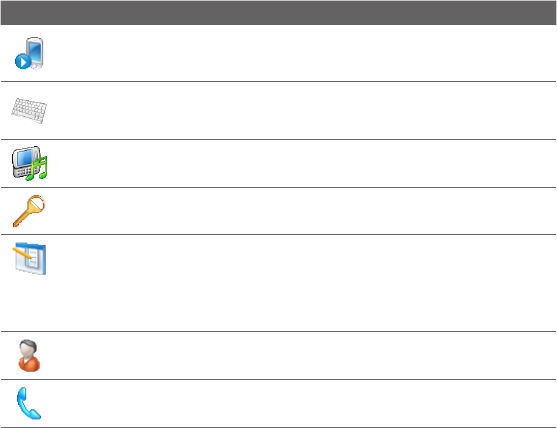
Managing Your Device 201
Settings on Your Device13.2
You can adjust the device settings to suit the way you work. Use the Settings tab to
adjust basic device settings. See “Settings” in Chapter 3 for details.
To see all available settings, tap Start > Settings, and then tap All Settings.
Personal tab
Icon Description
Buttons Assign a program or function to a hardware button or set the function
you want to execute (for instance, lock the device) when you press and hold the
END button.
Input Set options for each of the input methods. For instance, you can set the
device to play a sound or vibrate when you tap a Full QWERTY or Phone Keypad
key.
Keyboard Sliding Sound Select a sound to play when you open and close the
hardware keyboard.
Lock Set a password for your device.
Menus Set which programs appear in the Start menu.
Note The Start menu is disabled when the TouchFLO 3D Home screen
is enabled. To enable the Start menu, tap Start > Settings, tap All
Settings > Personal tab > Today > Items tab, and then clear the
TouchFLO 3D check box.
Owner Information Enter your personal information on your device.
Phone Customize phone settings such as the ring tone, or set a PIN number for
your SIM card.
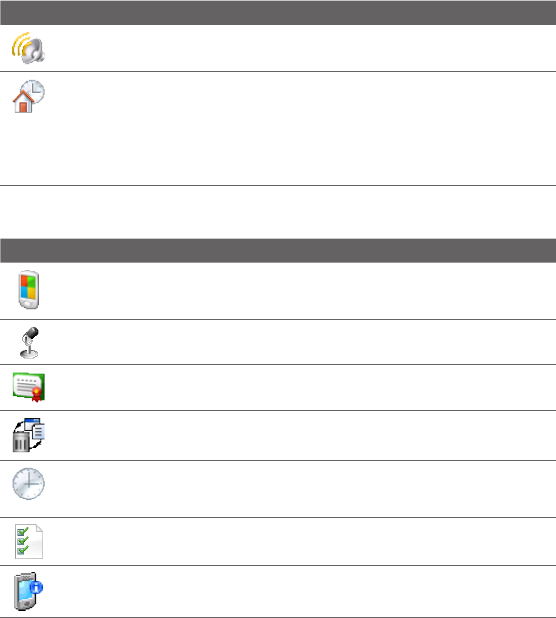
202 Managing Your Device
Icon Description
Sounds & Notifications Enable sounds for events, notifications, and more, and
set the type of notification for different events.
Today Customize the appearance of the Home screen and the information to
display on it.
Note You will not see the Today screen when the TouchFLO 3D Home screen
is enabled. To display the Today screen, tap Start > Settings button, tap
All Settings > Personal tab > Today > Items tab, and then clear the
TouchFLO 3D check box.
System tab
Icon Description
About This is where you can see basic information such as the Windows Mobile®
version and type of processor used on your device. You can also specify a name
for your device.
Auto Volume Control Automatically adjust the recording volume to an even
level.
Certificates See information about certificates that are installed on your device.
Clear Storage Reset your device to factory default settings.
Clock & Alarms Set the device clock to the date and time of your locale or to a
time zone you are visiting. Alarms can also be set on specified days and times of
the week.
Customer Feedback Set your device to automatically send information about
how you use Windows Mobile. By default, this option is disabled.
Device Information See information about the firmware version, hardware,
identity, and the duration of calls made on your device.
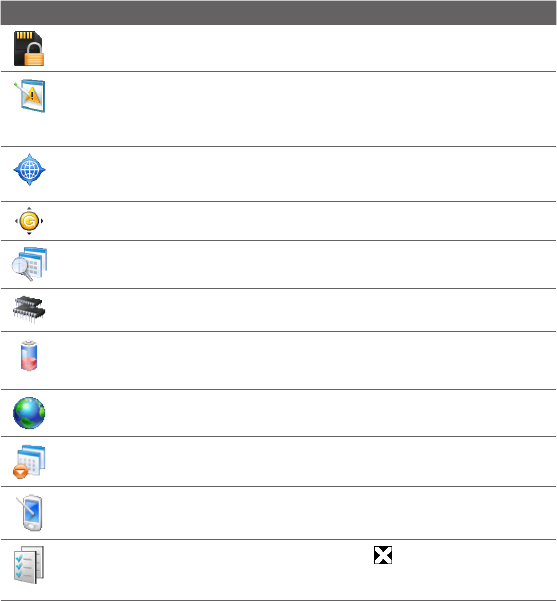
Managing Your Device 203
Icon Description
Encryption Encrypt files on your storage card. Encrypted files are only readable
on your device.
Error Reporting Enable or disable the device's error reporting function. When
this function is enabled and a program error occurs, technical data about the
state of the program and your computer is logged in a text file and delivered to
Microsoft's technical support if you choose to send it.
External GPS Set the appropriate GPS communication ports, if required. You may
need to do this when there are programs on your device that access GPS data or
you have connected a GPS receiver to your device.
G-Sensor Recalibrate the G-Sensor of the device. Use this function when
auto-rotate is not working properly.
Managed Programs Displays the programs that were installed on your device
using System Center Mobile Device Manager.
Memory Check the device memory allocation and storage card information.
Power Check the remaining battery power. You can also set the brightness of
the backlight and the timeout for turning off the display (switching the device to
Sleep mode) to conserve battery power.
Regional Settings Set the regional configuration to use, including the format for
displaying numbers, currency, date, and time on your device.
Remove Programs Uninstall programs that you previously installed on your
device.
Screen Recalibrate the screen, apply ClearType to display text more clearly, and
change the screen text size.
Task Manager Stop running programs and set the ( ) button to end programs
immediately when you tap the button. For more information, see “Using Task
Manager” in this chapter.
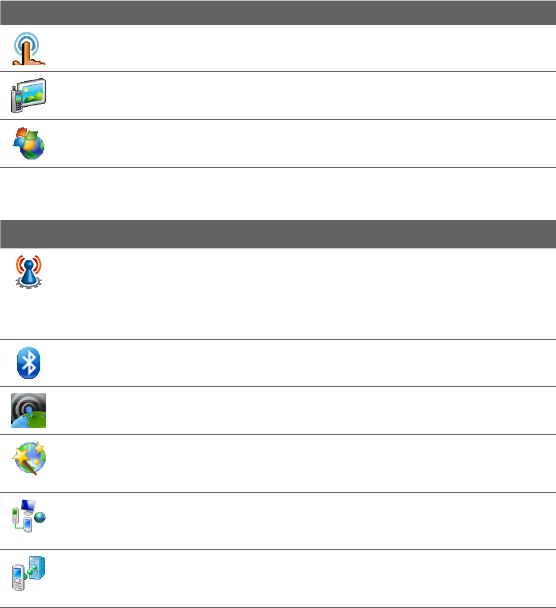
204 Managing Your Device
Icon Description
TouchFLO Set the device to vibrate when you tap the tabs, links, or other
onscreen items of supported applications.
TV Out Set the video standard to use when outputting to an external display.
Windows Update Link to Microsoft's web site and update Windows Mobile® on
your device with the latest security patches or fixes, if they are available.
Connections tab
Icon Description
Advanced Network Turn HSPA on/off, set the GPRS authentication method, and
set the line type to use when making a circuit switch data (CSD) connection. HSPA
is a 3.5G digital data service that provides high-speed downstream/upstream
data rates. Check with your wireless service provider whether HSPA is supported
in your area.
Bluetooth Turn Bluetooth on, set your device to visible mode, and scan for other
Bluetooth devices.
Comm Manager Manage your device’s connections (including the phone,
GPRS/3G, Wi-Fi, and Bluetooth) or turn the phone function on or off.
Connection Setup Configure your device’s data connections, such as GPRS, and
WAP, based on the detected SIM card or selected network operator. See “Using
Connection Setup” in this chapter for details.
Connections Set up one or more types of modem connection for your device,
such as phone dial-up and GPRS, so that your device can connect to the Internet
or a private local network.
Domain Enroll Enroll your device in your company’s domain to let System Center
Mobile Device Manager manage the device. Ask your network administrator for
more details.

Managing Your Device 205
Icon Description
USB to PC Set the type of USB connection to your PC. Select the ActiveSync
option for synchronizing data, or use Disk Drive mode for transferring files.
Wi-Fi Turn the Wi-Fi function on or off, scan for available wireless networks, see
information about the active wireless network, and customize Wi-Fi settings.
Changing 13.3 Basic Settings
Display settings
To manually adjust the screen brightness
By default, your device automatically adjusts the screen brightness according to the
ambient lighting.
1. Tap Start > Settings, and then tap All Settings.
2. On the System tab, tap Power > Backlight tab.
3. Clear the Auto adjust backlight check box.
4. Adjust the brightness by dragging the slider under On battery power and
On external power.
To automatically turn off the screen backlight when the phone is not in use
1. Tap Start > Settings, and then tap All Settings.
2. On the System tab, tap Power > Advanced tab.
3. In On battery power and On external power, specify the time before the
screen backlight turns off.
206 Managing Your Device
To increase or decrease the size of text on the screen
1. Tap Start > Settings, and then tap All Settings.
2. On the System tab, tap Screen > Text Size tab.
3. Move the slider to increase or decrease the text size.
To re-calibrate the touch screen
The device touch screen is calibrated before shipment. Re-calibrate the touch
screen if it does not accurately respond to screen taps.
1. While the device is on, press and hold the VOLUME UP and VOLUME DOWN
buttons, and then tap the screen to open the align screen.
2. Follow the on-screen instructions to complete the calibration.
Device name
The device name is used to identify your device when synchronizing with a
computer, connecting to a network, or restoring information from a backup.
Note If you synchronize multiple devices with the same computer, each device must have a
unique name.
To change the device name
1. Tap Start > Settings, and then tap All Settings.
2. On the System tab, tap About > Device ID tab.
3. Enter the device name.
Notes• The device name must begin with a letter, consist of letters from A to Z, numbers from
0 to 9, and cannot contain spaces. Use the underscore character to separate words.
• If you enroll your device to your company’s domain, the device name will be
changed to be the same as the one used to enroll the device.
Managing Your Device 207
Ringer settings
To change the ring type and ring tone
1. Tap Start > Settings, and then tap Sound.
2. Scroll down and then tap Ring Type. Select the ring type you want to use,
and then tap Done.
3. Tap Ringtone, and then select the ring tone you want to use.
4. Tap Done.
Tips• You can use *.wav, *.mid, *.mp3, *.wma, or other types of sound files that you
downloaded from the Internet or copied from your computer. For a complete list
of supported audio file formats, see “Specifications” in the Appendix.
• To use your sound files as ring tones, copy them first to the /My Documents/My
Ringtones folder on your device, and then select the sound from the Ring tone
list of your device. For more information about copying files, see “Copying and
Managing Files” in this chapter.
To choose how to be notified about events or actions
1. Tap Start > Settings, and then tap Sound > Advanced.
2. On the Sounds tab, choose how you want to be notified by selecting the
appropriate check boxes.
3. On the Notifications tab, in Event, tap a ring type and ring tone for that
event or action from the lists below.
Tip Turning off sound notifications helps conserve battery power.
208 Managing Your Device
Phone services
You can change the settings of various phone services for your device. Phone
services may include Call Forwarding, Call Waiting, Voicemail, and more. Contact
your wireless service provider to find out about the availability of phone services for
your device.
To access and change settings of phone services
1. Tap Start > Settings, and then tap Communications.
2. On the Comm Manager screen, tap Phone > Phone services.
3. Select the service you want to use, and then tap Get Settings.
4. Choose your desired options, and then tap OK.
13.4 Using Connection Setup
After you insert a new SIM card and power on your device, you can use Connection
Setup to automatically configure your device’s data connections, such as 3G/GPRS
and WAP.
Note For details on how to automatically configure the data connections, see “Auto
configuring data connection settings and importing SIM contacts” in Chapter 1.
To manually select the network operator to use for data connections
You can manually select your network operator and allow Connection Setup to
reconfigure your device’s data connections settings based on the selected operator.
1. Tap Start > Settings, and then tap All Settings.
2. On the Connections tab, tap Connection Setup.
3. Select the network Country and Operator you want to use, then tap OK.
Note If you choose a country and/or operator that is different from the installed SIM
card network operator, you may not be able to access network services.
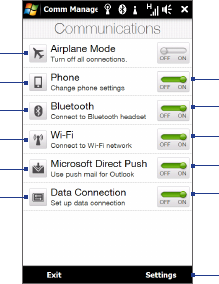
Managing Your Device 209
4. When prompted to confirm whether you want to configure the data
connection settings, tap Yes.
5. After Connection Setup completes the configuration, tap Restart.
Using Comm Manager13.5
Comm Manager lets you easily turn on and off the communication features of your
device such as the phone, Bluetooth, Wi-Fi, and data connection.
To access Comm Manager
Tap Start > Settings, and then tap Communications.
1
3
2
4
5
6
7
9
8
10
11
12
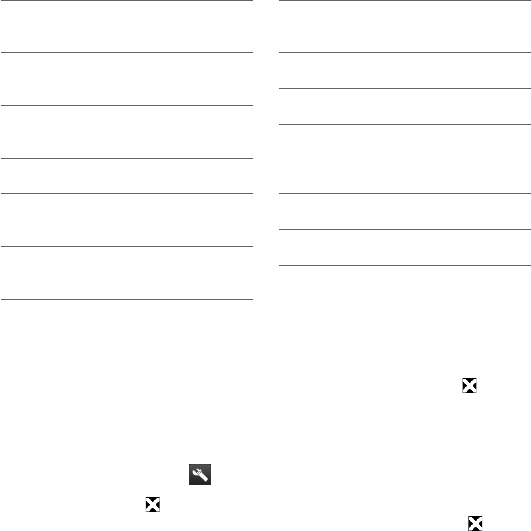
210 Managing Your Device
1
Switch Airplane Mode on or off.
See “Turning the Phone Function On
and Off” in Chapter 2.
2
Access the phone settings and
change the PIN codes, configure
phone services, and more.
3
Connect a Bluetooth headset or
other Bluetooth-enabled device. See
Chapter 9 for details.
4
Connect to a wireless network.
See Chapter 8 for details.
5
Open ActiveSync and adjust the
push e-mail settings. See Chapter 7
for details.
6
Open Connection Setup and
automatically configure your data
connection settings.
7
Switch the phone on or off.
See “Turning the Phone Function On
and Off” in Chapter 2.
8
Switch Bluetooth on or off.
See Chapter 9 for details.
9
Switch Wi-Fi on or off.
See Chapter 8 for details.
10
Switch between automatically
receiving (as items arrive) or manually
retrieving Outlook e-mail messages.
See Chapter 7 for details.
11
Connect or disconnect active data
connections (3G/GPRS, or EDGE).
12
Adjust the phone, Bluetooth, and
Wi-Fi settings.
Using 13.6 Task Manager
Task Manager lets you view and stop running programs, configure the button,
and enable the Quick Menu on the Home screen.
To open Task Manager
Tap the Quick Menu button on the top-right corner of the Home screen to open
the Quick Menu, and then tap .
To configure the Exit ( ) button
By default, running programs are shut down when you tap and hold the button.
1. On the Task Manager screen, tap the Button tab.
Note When you clear Enable the “X” button to end running programs, tapping
the Exit button only closes a program screen. The program is not ended and
continues to run in the background.

Managing Your Device 211
2. Choose the action for shutting down programs (by tapping the button, or
by tapping and holding the button).
3. Tap OK.
To add a running program to the exclusive list
If you add a running program to the Exclusive Programs List, it will not be closed
when you tap Stop Selected or Stop All and will not be listed in the Quick Menu
on the Home Screen.
1. On the Task Manager screen, tap the Running tab.
2. Tap and hold the program name, and then tap Add Exclusive.
Tip To remove a program from the exclusive list, tap and hold the program on the
Running tab, then tap Remove from Exclusive.
Protecting Your Device13.7
Protecting your SIM card with a PIN
You can protect your SIM card by requiring a PIN (personal identification number)
every time the device is turned on. You will not be able to use the phone or the data
connection until you enter the correct PIN.
To enable the SIM card PIN
1. Tap Start > Settings, and then tap Communications.
2. On the Comm Manager screen, tap Phone > PIN Code.
3. Enter the PIN, tap OK, and then tap OK on the dialog box.
Tips • To change the PIN, tap Change PIN on the Phone Settings screen.
• Emergency calls can be placed at any time, without requiring a PIN.
212 Managing Your Device
Protecting your phone with a password
You can help keep your data more secure by requiring a password every time the
device is turned on.
To set a device password
1. Tap Start > Settings, and then tap All Settings.
2. On the Personal tab, tap Lock.
3. Select the Prompt if device unused for check box, then specify the idle time
before the device requires a password.
4. In the Password type box, select the type of password you would like to use.
Tip If your device is configured to connect to a network, use an alphanumeric
password for increased security.
5. Enter the password in both the Password and Confirm boxes.
6. Tap OK. The next time the device is turned on, you will be prompted to enter
your password.
Notes • To ensure that you can always make emergency calls, do not begin your password
with the digits of your local emergency number.
• If you entered a hint, the hint will be displayed after the wrong password is entered
five times.
• Each time a wrong password is entered, the device response time gets longer until
the device appears to be not responding.
• If you forget your password, you can hard reset or clear the device memory. For
more information about hard resetting the device and clearing the memory, see
“Resetting Your Device”.
Managing Your Device 213
Encrypting files on your storage card
You can set your device to encrypt files as they are saved on the storage card.
1. Tap Start > Settings, and then tap All Settings.
2. On the System tab, tap Encryption.
3. Select Encrypt files when placed on a storage card.
Notes • Encrypted files can only be read on the device that encrypted them.
• Encrypted files are opened just like other files, provided you are using the device
that encrypted them. There is no separate step for you to take to read these files.
Important If Encrypt files when placed on a storage card is enabled, backup all files from
the storage card before using Clear Storage, hard reset, or updating the operating
system. Otherwise you will no longer be able to access the encrypted files on the
storage card. Use ActiveSync or Windows Mobile Device Center to transfer files
between your storage card and computer. After the procedure, copy your files
back to the storage card.
Resetting Your Phone13.8
Performing a soft reset
Perform a soft (normal) reset to clear all active program memory and shut down all
active programs. This is useful when your device is running slower than normal, or a
program is not performing properly. If a soft reset is performed when programs are
running, unsaved work is lost.
To perform a soft reset
1. Pull out the stylus.
2. Remove the back cover. For instructions, see “To remove the back cover” in
Chapter 1.
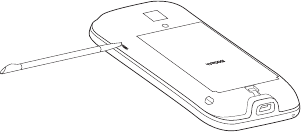
214 Managing Your Device
3. Use the stylus tip to press the RESET button located at the upper-left side of
the open back panel.
Your device restarts and displays the Home screen.
4. Replace the back cover and insert the stylus back into its compartment.
Performing a hard reset
If a normal reset does not solve a system problem, you can perform a hard (full)
reset. After a hard reset, the device is restored to its default settings—the way it
was when you first purchased it and turned it on. You will lose any programs you
installed, data you entered, and settings you customized on your device, and only
Windows Mobile® software and other pre-installed programs will remain.
Warning! Your device will be set back to factory default settings. Make sure that any
additional installed programs and/or user data have been backed up before you
perform a hard reset.
Important If Encrypt files when placed on a storage card is enabled, backup all files from
the storage card before using Clear Storage, hard reset, or updating the operating
system. Otherwise you will no longer be able to access the encrypted files on the
storage card. Use ActiveSync or Windows Mobile Device Center to transfer files
between your storage card and computer. After the procedure, copy your files
back to the storage card.

Managing Your Device 215
To perform a hard reset
1. With the device turned off, press and hold the TALK/SEND, END and POWER
buttons until you see this message on the screen.
This operation will delete
all your personal data,
and reset all settings
to manufacturer default.
Press VolUp to restore
manufacturer default, or
press other keys to cancel.
2. Release the TALK/SEND, END and POWER buttons.
3. Press the VOLUME UP button to perform the hard reset, or press any other
button to cancel the reset.
Using Clear Storage
If you can access the device settings, you can use Clear Storage to reset your device
back to factory default settings.
1. Tap Start > Settings, and then tap All Settings.
2. On the System tab, tap Clear Storage.
3. Enter “1234” and then tap Yes.
216 Managing Your Device
13.9 Windows Update
Update Windows Mobile® with the latest security patches and fixes from Microsoft,
if these are available.
To set up Windows Update
The first time you run Windows Update, you need to set up how you want Windows
Update to check for updates.
1. Tap Start > Settings, and then tap All Settings.
2. On the System tab, tap Windows Update.
3. On the Update Setup screen, tap Next.
4. Choose how you want to check for updates, then tap Next.
Note If you select Automatic, you are asked if you want to use your current data plan
to check for updates. Select or clear the Use my data plan to check for and
download updates check box, and tap Next.
5. Tap Finish.
To check for updates
1. Tap Start > Settings, and then tap All Settings.
2. On the System tab, tap Windows Update.
3. Tap Check Now.
To change Windows Update options
1. Tap Start > Settings, and then tap All Settings.
2. On the System tab, tap Windows Update.
3. Tap Menu > Connections to change how the device connects to the Internet
when checking for updates, or tap Menu > Change Schedule to change how
Windows Update checks for Windows Mobile® updates.

Appendix
SpecificationsA.1
Processor Qualcomm® MSM7225™, 528 MHz
Operating System Windows Mobile® 6.5 Professional
Memory ROM : 512 MB•
RAM : 256 MB•
Dimensions (LxWxT) 104 X 55 X 12.9 mm (4.1 X 2.16 X 0.51 inches)
Weight 110 g (4 ounces) with battery
Display 2.8-inch TFT-LCD touch-sensitive screen with QVGA resolution
Network HSDPA/WCDMA:
900/2100 MHz•
Up to 384 kbps up-link and 7.2 Mbps down-link speeds•
Quad-band GSM/GPRS/EDGE:
850/900/1800/1900 MHz•
(Band frequency and data speed are operator dependent.)
Device Control HTC TouchFLO™•
Zoom bar•
GPS Internal GPS antenna
Connectivity Bluetooth® 2.1 with Enhanced Data Rate and A2DP for stereo •
wireless headsets
Wi-Fi®: IEEE 802.11 b/g•
HTC ExtUSB™ (11-pin mini-USB 2.0 and audio jack in one)•
Camera 3.2 megapixel color camera with fixed focus
Audio supported
formats
AAC, AAC+, eAAC+, AMR-NB, AMR-WB, QCP, MP3, WMA, WAV,
MIDI, M4A

218 Appendix
Video supported
formats
WMV, ASF, MP4, 3GP, 3G2, M4V, AVI
Battery Rechargeable Lithium-ion battery•
Capacity: 1100 mAh•
Talk time: Up to 4.5 hours for WCDMA•
Up to 5.5 hours for GSM
Standby time: Up to 396 hours for WCDMA•
Up to 285 hours for GSM
(The above are subject to network and phone usage.)
Expansion Slot microSD™ memory card (SD 2.0 compatible)
AC Adapter Voltage range/frequency: 100 - 240V AC, 50/60 Hz
DC output: 5V and 1A
Notes • The memory size figures are the total ROM and RAM memory available for use and
storage. Since the memory is shared by the operating system, applications, and
data, the actual available memory is less than what is specified.
• Specifications are subject to change without prior notice.
Appendix 219
Regulatory NoticesA.2
Regulatory Agency Identifications
For regulatory identification purposes, your product is assigned a model number of
PB74120.
To ensure continued reliable and safe operation of your device, use only the
accessories listed below with your PB74120.
The Battery Pack has been assigned a model number of TOPA160.
Note This product is intended for use with a certified Class 2 Limited Power Source, rated 5
Volts DC, maximum 1 Amp power supply unit.
Federal Communications Commission Notice
This device complies with part 15 of the FCC Rules. Operation is subject to the
following two conditions: (1) This device may not cause harmful interference, and
(2) this device must accept any interference received, including interference that
may cause undesired operation.
This equipment has been tested and found to comply with the limits for a Class
B digital device, pursuant to Part 15 of the FCC Rules. These limits are designed
to provide reasonable protection against harmful interference in a residential
installation. This equipment generates, uses, and can radiate radio frequency
energy and, if not installed and used in accordance with the instructions, may cause
harmful interference to radio communications. However, there is no guarantee that
interference will not occur in a particular installation. If this equipment does cause
harm-ful interference to radio or TV reception, which can be determined by turning
the equipment on and off, the user is encouraged to try to correct the interference
by one or more of the following measures:
• Reorient or relocate the receiving antenna.
• Increase the separation between the equipment and receiver.
220 Appendix
• Connect the equipment into an outlet on a circuit different from that to
which the receiver is connected.
• Consult the dealer or an experienced radio or television technician for help.
Modifications
The FCC requires the user to be notified that any changes or modifications made to
the device that are not expressly approved by HTC Corporation may void the user’s
authority to operate the equipment.
Safety precautions for RF exposure
• Use only original manufacturer-approved accessories, or accessories that do
not contain any metal.
• Use of non-original manufacturer-approved accessories may violate your
local RF exposure guidelines and should be avoided.
Exposure to Radio Frequency (RF) Signals
Your device contains a radio transmitter and receiver. The radiated output power
is far below the international radio frequency exposure limits. These limits are part
of comprehensive guidelines and establish permitted levels of RF energy for the
general population. The guidelines are based on the safety standards previously set
by international standards bodies:
• American National Standards Institute (ANSI) IEEE. C95.1-1992
• National Council on Radiation Protection and Measurement (NCRP). Report
86. 1986
• International Commission on Non-Ionizing Radiation Protection (ICNIRP) 1996
• Ministry of Health (Canada), Safety Code 6. The standards include a
substantial safety margin designed to assure the safety of all persons,
regardless of age and health.
Appendix 221
The exposure standard for wireless mobile phones employs a unit of measurement
known as the Specific Absorption Rate, or SAR. The standard incorporates a
substantial margin of safety to give additional protection for the public and to
account for any variations in usage.
As with other mobile radio transmitting equipment, users are advised that for
satisfactory operation of the equipment and for the safety of personnel, it is
recommended that no part of the human body be allowed to come too close to the
antenna during operation of the equipment.
Your device has an internal antenna. Use only the supplied integral antenna. Use of
unauthorized or modified antennas may impair call quality and damage the phone,
causing loss of performance and SAR levels exceeding the recommended limits as
well as result in non-compliance with local regulatory requirements in your country.
To assure optimal phone performance and ensure human exposure to RF energy
is within the guidelines set forth in the relevant standards; always use your
device only in its normal-use position. Do not touch or hold the antenna area
unnecessarily when placing or receiving a phone call. Contact with the antenna
area may impair call quality and cause your device to operate at a higher power
level than needed. Avoiding contact with the antenna area when the phone is IN
USE optimizes the antenna performance and the battery life.
Tests for SAR are conducted using standard operating positions specified by
the FCC with the phone transmitting at its highest certified power level in all
tested frequency bands. Although the SAR is determined at the highest certified
power level, the actual SAR level of the phone while operation can be well
below the maximum value. This is because the phone is designed to operate at
multiple power levels so as to use only the power required to reach the network.
In general, the closer you are to a wireless base station antenna, the lower the
power output. Before a phone model is available for sale to the public, it must be
tested and certified to the FCC that it does not exceed the limit established by
the government-adopted requirement for safe exposure. This phone has been
tested and meets the FCC RF exposure guidelines when used with an accessory
222 Appendix
that contains no metal and that positions the handset a minimum of 1.5 cm from
the body. For body worn operation, to maintain compliance with FCC RF exposure
guidelines, use only HTC Corporation approved accessories. When carrying the
phone while it is on, use the HTC Corporation supplied or approved carrying case,
holster, or other body-worn accessory. Use of non HTC Corporation approved
accessories may violate FCC RF exposure guidelines and should be avoided.
SAR Information
1.080 w/kg@1g (Head)
0.879 w/kg@1g (Body)
Telecommunications & Internet Association (TIA)
Safety Information
Pacemakers
The Health Industry Manufacturers Association recommends that a minimum
separation of six inches be maintained between a handheld wireless phone
and a pacemaker to avoid potential interference with the pacemaker. These
recommendations are consistent with the independent research by and
recommendations of Wireless Technology Research. Persons with pacemakers:
• Should ALWAYS keep the phone more than six inches from their pacemaker
when the phone is turned ON.
• Should not carry the phone in a breast pocket.
• Should use the ear opposite the pacemaker to minimize the potential for
interference. If you have any reason to suspect that interference is taking
place, turn the phone OFF immediately.
Hearing Aids
Some digital wireless phones may interfere with some hearing aids. In the event
of such interference, you may want to consult your service provider, or call the
customer service line to discuss alternatives.

Appendix 223
Other Medical Devices
If you use any other personal medical device, consult the manufacturer of your
device to determine if they are adequately shielded from external RF energy. Your
physician may be able to assist you in obtaining this information.
Turn the phone OFF in health care facilities when any regulations posted in
these areas instruct you to do so. Hospitals or health care facilities may be using
equipment that could be sensitive to external RF energy.
WEEE Notice
The Directive on Waste Electrical and Electronic Equipment (WEEE), which entered
into force as European law on 13th February 2003, resulted in a major change in the
treatment of electrical equipment at end-of-life.
The purpose of this Directive is, as a first priority, the prevention of WEEE, and
in addition, to promote the reuse, recycling and other forms of recovery of such
wastes so as to reduce disposal.
The WEEE logo (shown at the left) on the product or on its box indicates
that this product must not be disposed of or dumped with your other
household waste. You are liable to dispose of all your electronic or
electrical waste equipment by relocating over to the specified collection
point for recycling of such hazardous waste. Isolated collection and
proper recovery of your electronic and electrical waste equipment at
the time of disposal will allow us to help conserving natural resources.
Moreover, proper recycling of the electronic and electrical waste
equipment will ensure safety of human health and environment. For
more information about electronic and electrical waste equipment
disposal, recovery, and collection points, please contact your local
city center, household waste disposal service, shop from where you
purchased the equipment, or manufacturer of the equipment.
224 Appendix
RoHS Compliance
This product is in compliance with Directive 2002/95/EC of the European
Parliament and of the Council of 27 January 2003, on the restriction of the use of
certain hazardous substances in electrical and electronic equipment (RoHS) and its
amendments.